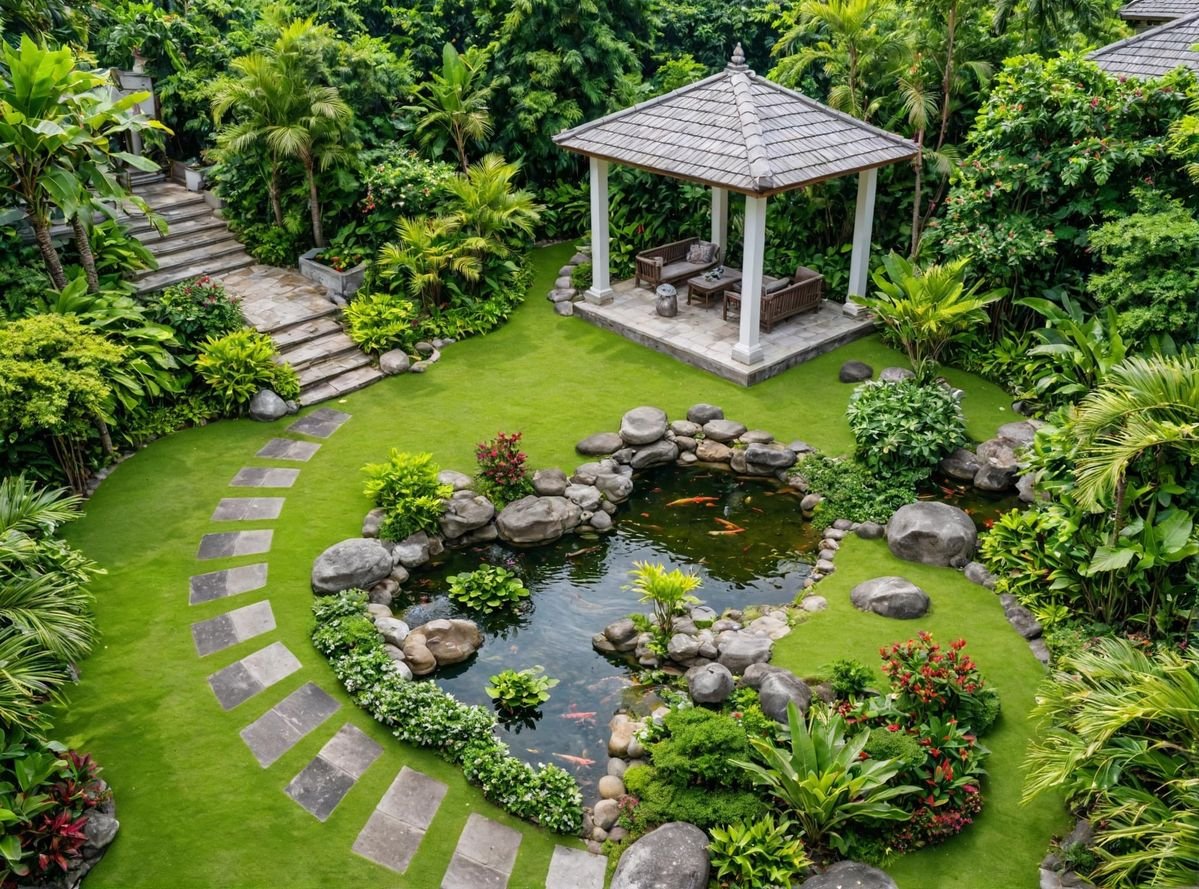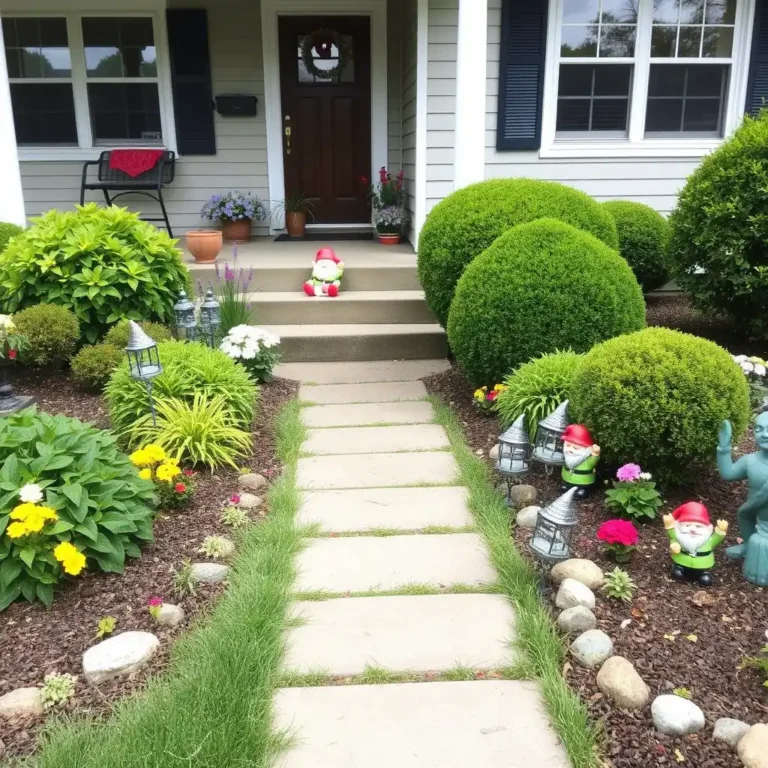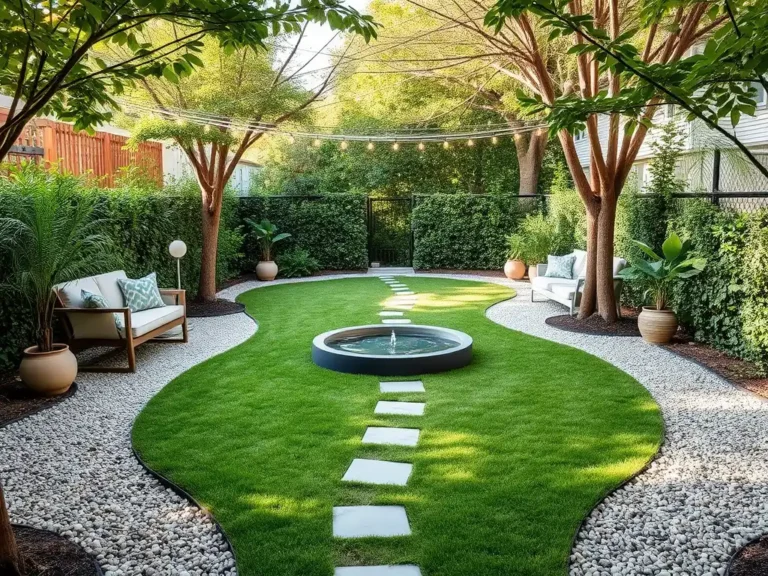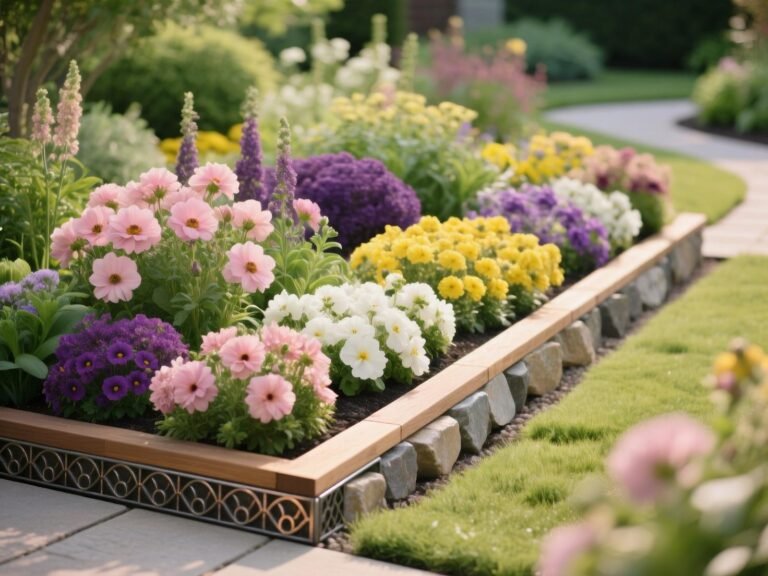15 Modern Japanese Garden Landscapes That Blend Tradition with Contemporary Style

Traditional Japanese gardens carry centuries of wisdom, but let’s be honest—some elements feel too historical for today’s homes.
You want that peaceful aesthetic without feeling like you’re living in a museum or recreating a tourist attraction.
The challenge is finding the balance between timeless principles and contemporary living.
Modern Japanese garden landscapes solve this beautifully by keeping the philosophy while updating the execution.
These designs embrace minimalism, clean lines, and innovative materials that work with contemporary architecture.
The result feels both rooted in tradition and completely current, creating outdoor spaces that suit how we actually live today.
We’re covering 15 modern Japanese garden landscapes that reinterpret classic elements for contemporary settings.
You’ll find sleek water features, minimalist plant palettes, architectural hardscaping, and design approaches that honor Japanese aesthetics while feeling fresh and current.
Let’s explore how Japanese garden principles evolve for modern spaces while maintaining their soul.
How Modern Interpretations Differ from Traditional Gardens
- Simplified Plant Palettes Replace Diverse Collections: Modern designs use fewer plant varieties with bolder massing for cleaner visual impact. It’s like editing a complex recipe down to essential ingredients that deliver maximum flavor with minimal components. Three plant types thoughtfully arranged outperform ten varieties competing for attention.
- Contemporary Materials Join Natural Elements: Steel, concrete, and glass integrate with stone and wood, creating dialogue between industrial and organic. It’s like speaking two languages fluently where modern materials enhance rather than contradict natural ones. The contrast creates visual tension that feels intentionally designed.
- Geometric Forms Meet Organic Shapes: Sharp angles and clean lines frame natural elements rather than exclusively using curved, flowing forms. It’s like pairing a tailored jacket with relaxed jeans where structured meets casual successfully. The juxtaposition highlights each element’s character through contrast.
- Functional Spaces Balance Contemplative Zones: Modern gardens accommodate dining, entertaining, and active family use alongside meditation areas. It’s like designing for real life rather than purely aesthetic contemplation. The gardens work harder by serving multiple purposes without losing peaceful character.
15 Modern Japanese Garden Landscapes
Transform your outdoor space with these modern Japanese garden landscapes that honor tradition while embracing contemporary design.
Concrete and Bamboo Minimalism
Pair sleek concrete surfaces with vertical bamboo plantings for stark contrast between industrial and natural. The material juxtaposition creates modern tension while maintaining Japanese simplicity. It’s like designing with opposites that enhance each other through difference.
Use poured concrete for pathways, walls, or seating elements finished smooth or with exposed aggregate. Plant clumping bamboo in clean-lined metal or concrete planters for controlled growth. The limited palette of gray concrete and green bamboo creates sophisticated restraint perfect for contemporary homes.
Linear Reflection Pool
Install a long, narrow reflecting pool with precise edges that mirror sky and surrounding architecture. The geometric water feature adds serenity through simplicity and reflection. It’s like placing a liquid mirror that captures changing light throughout the day.
Construct the pool using concrete or steel with clean 90-degree corners rather than organic shapes. Keep it shallow—6 to 12 inches—for safety and minimal maintenance. The still water surface becomes a design element that expands perceived space through reflection.
Sculptural Stone Grouping
Arrange large, dramatic boulders as contemporary sculpture rather than naturalistic mountain representations. The stones become art pieces showcasing form, color, and texture boldly. It’s like displaying museum-quality geology in your garden.
Select stones with striking characteristics—unusual colors, dramatic veining, or geometric fractures. Position them with more space between rocks than traditional arrangements allow. The isolation emphasizes each stone’s individual character while negative space becomes equally important design element.
Steel-Framed Gravel Garden
Define zen rock garden areas using weathering steel frames that create clean boundaries. The rusted metal edges provide modern structure for traditional gravel compositions. It’s like framing classical art in contemporary gallery setting.
Install Corten steel edging in geometric shapes—rectangles, squares, or linear runs. Fill with light gravel raked in simple patterns rather than elaborate traditional designs. The steel develops rich rust patina that contrasts beautifully with pale stone.
Architectural Privacy Screens
Create privacy using slatted wood or metal screens in geometric patterns that filter views while adding design interest. The screens function as garden walls with visual permeability. It’s like using transparent barriers that define space without completely enclosing it.
Choose horizontal slats in black metal for industrial modern or natural cedar for warmer contemporary. Space slats to allow partial visibility and air circulation while blocking direct sightlines. The screening creates privacy that feels open rather than claustrophobic.
Monochromatic Plant Design
Select plants exclusively in greens ranging from chartreuse to forest, eliminating flower color for ultimate restraint. The varied green tones create depth through subtle variation. It’s like painting with a single color family where texture replaces hue.
Choose architectural plants—boxwood spheres, columnar evergreens, ornamental grasses—with distinct forms that read clearly. Layer different green shades from lime to deep emerald for dimensional interest. The absence of flower color creates calm that never feels chaotic.
Floating Wooden Deck
Install a low deck that appears to hover above the ground plane, creating visual lightness. The suspended platform provides modern viewing area with traditional engawa function. It’s like building furniture that floats rather than sits heavily.
Construct using hidden structural supports so the deck appears cantilevered from your home. Use composite decking in charcoal or dark wood tones for contemporary appeal. The floating effect creates architectural drama while providing functional outdoor living space.
Glass and Steel Water Wall
Mount a sheet of glass with water flowing down its surface for vertical water feature. The transparent waterfall adds sound and movement in compact footprint. It’s like installing a window that flows continuously.
Position the glass panel against a wall or as freestanding element with steel frame. LED lighting behind or below the glass creates nighttime drama. The modern feature provides water’s benefits without traditional pond maintenance.
Black Stone Mulch Beds
Replace traditional light gravel with dramatic black lava rock or river stone. The dark mulch creates bold contrast with green foliage and lighter hardscaping. It’s like using a dark background that makes plants pop visually.
Apply black stone 2 to 3 inches deep over landscape fabric in planting beds. The dark color absorbs heat and hides dirt better than light stone. The contemporary look suits modern homes while suppressing weeds effectively.
Grid-Pattern Stepping Stones
Lay square pavers in precise grid formation rather than organic stepping patterns. The geometric arrangement creates modern order while guiding movement. It’s like using mathematical precision where traditional designs favored natural randomness.
Use large format concrete pavers in uniform sizes spaced consistently. Fill gaps with gravel, moss, or low groundcover in contrasting colors. The grid creates visual strength that feels contemporary while serving traditional pathway function.
Specimen Grass Feature
Showcase dramatic ornamental grasses as standalone focal points rather than border fillers. Single grass clumps become sculptural elements that move and catch light. It’s like elevating supporting actors to starring roles.
Choose architectural varieties like giant miscanthus, purple fountain grass, or Japanese forest grass in bold positions. Give each specimen space to display its form fully without crowding. The flowing movement adds life while maintaining modern simplicity.
Concrete Bench Seating
Install built-in concrete benches with clean lines and minimalist form. The permanent seating provides functional resting spots with sculptural presence. It’s like furniture that’s also architecture blending seamlessly into landscape design.
Pour concrete benches in simple geometric forms—rectangular, L-shaped, or curved. Polish surfaces smooth or leave naturally textured depending on desired finish. Add cushions temporarily when in use or enjoy the raw material aesthetic.
Vertical Green Wall Panel
Create a living wall using modular planting systems filled with ferns, moss, or succulents. The vertical garden adds greenery without consuming floor space. It’s like turning blank walls into planted surfaces.
Install professional green wall systems or DIY using pocket planters mounted to sturdy backing. Choose plants suited to your wall’s light exposure and maintenance commitment. The vertical approach suits modern spaces where horizontal square footage is limited.
Lighting as Sculpture
Use contemporary LED fixtures as design elements rather than hiding lights. The modern luminaires provide illumination while contributing to daytime aesthetics. It’s like art installations that happen to light your garden.
Select fixtures with architectural presence—geometric forms, interesting finishes, or sculptural shapes. Position them to uplight specimen plants, graze textured walls, or spotlight key features. The fixtures become garden elements whether illuminated or dark.
Succulent and Cactus Palette
Replace traditional Japanese plants with drought-tolerant succulents arranged in Japanese compositional style. The unexpected plant choices bring modern twist to classic arrangement principles. It’s like speaking Japanese with a contemporary accent.
Group succulents following odd-number rules and asymmetric balance traditional to Japanese design. Use architectural varieties like agave, aloe, and sculptural cacti. The water-wise approach suits modern environmental consciousness while maintaining aesthetic principles.
Balancing Modern and Traditional Elements
- Keep Core Principles While Updating Execution: Maintain simplicity, asymmetry, and natural materials even when using contemporary forms. It’s like honoring the spirit of tradition while adapting its body to current times. The philosophy matters more than literal replication of historical styles.
- Let Materials Develop Natural Patina: Allow steel to rust, concrete to age, and wood to weather rather than fighting material changes. It’s like embracing wabi-sabi where imperfection and aging add beauty. The weathered appearance connects modern materials to traditional aesthetic values.
- Create Contrast Intentionally: Position smooth against rough, light against dark, geometric against organic deliberately. It’s like composing visual music where contrasts create interest and harmony simultaneously. Random contrasts confuse while planned ones clarify design intent.
- Design for Human Use: Include functional seating, dining areas, and circulation rather than purely contemplative spaces. It’s like remembering gardens exist for living people who need to actually use outdoor spaces. The functionality doesn’t diminish peacefulness when thoughtfully integrated.
Lets End!
Modern Japanese garden landscapes prove that peaceful design doesn’t require historical recreation. These contemporary interpretations honor traditional wisdom while speaking today’s aesthetic language. Your garden can feel both timeless and current when built on solid principles expressed through modern materials and forms.
Start with your home’s architecture as foundation for design decisions. Modern gardens work best when they extend interior aesthetics outdoors rather than creating disconnected separate worlds. Choose materials and forms that bridge inside and outside through shared language of simplicity and quality.
Remember that restraint remains central to both traditional and modern Japanese design. The temptation to add just one more element undermines the peaceful simplicity these gardens provide.
Edit ruthlessly, keeping only what serves your vision clearly. Less truly means more when each element carries its weight beautifully.
What modern approach speaks to your space? Share your vision in the comments below!






